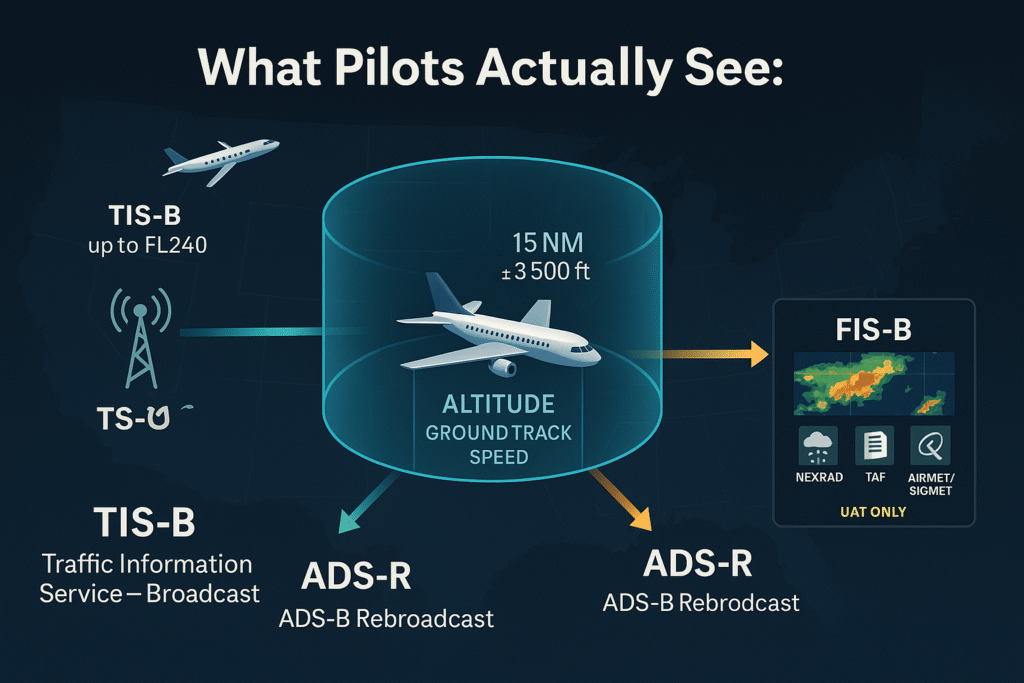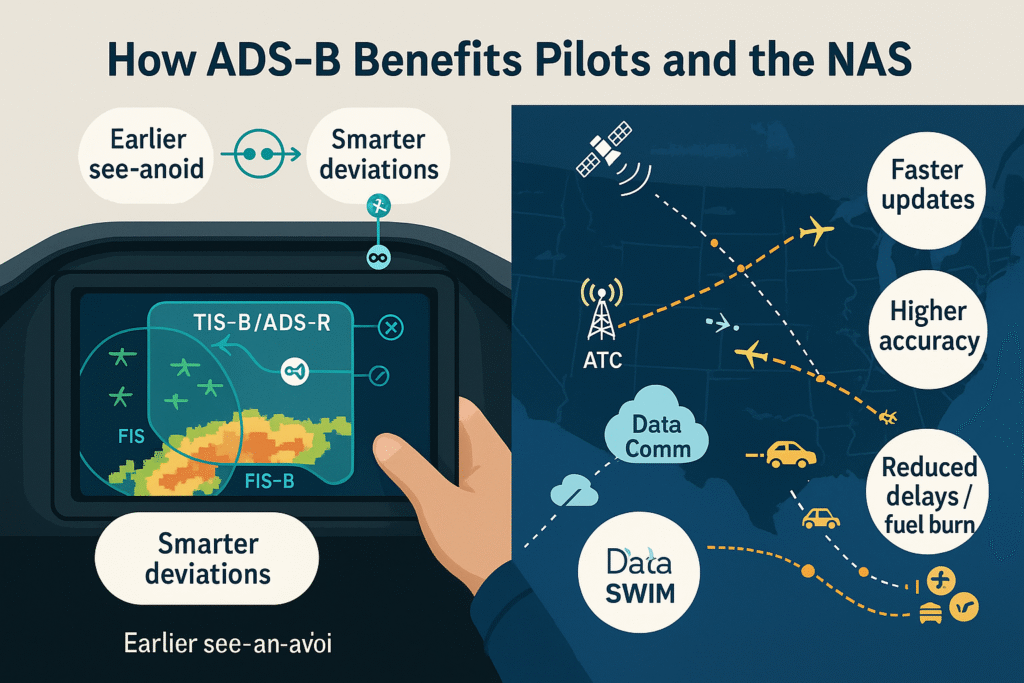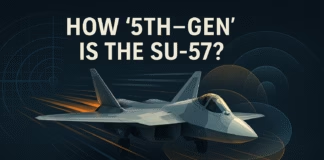I still remember the first time I sat in a TRACON back room watching my own flight crawl across the scope—not on a primary sweep, but as a crisp once-per-second track fed by our transponder’s extended squitter. The controller nudged me: “That’s your ADS-B, not radar. See how smooth the vector is?” That moment sells the whole idea. ADS-B (Automatic Dependent Surveillance–Broadcast) is the backbone of NextGen: aircraft continuously broadcast their GPS-derived position and velocity, ground sites ingest and fuse it with radar/multilateration, and automation such as ERAM/STARS turns it into the picture controllers and traffic-management tools actually use.
What ADS-B is—minus the jargon
“Automatic”: no pilot button-pushing once it’s installed and configured. “Dependent”: it relies on your navigation source (typically a certified GNSS). “Broadcast”: one-way, once per second, for anyone listening—FAA ground radios, other aircraft, the hobbyist on a hill with an SDR. This is also why privacy is a program, not a switch; you can filter FAA feeds or rotate identifiers, but you can’t un-broadcast RF. The FAA’s privacy page lays out what PIA (Privacy ICAO Address) and LADD (Limiting Aircraft Data Displayed) do—and what they don’t (FAA ADS-B Privacy).
From 2010 to the 2020 mandate, the FAA finished a national radio network and hard-wired the fusion into controller systems. The result in the seat? Tighter tracks, faster updates, better surface awareness—and fewer “say altitude” calls on busy finals.
ADS-B Out vs. ADS-B In (what’s required vs. what’s worth it)
- ADS-B Out is the rule. If you fly in the same places Mode C used to bite—Class A/B/C, the 30-NM Mode C veil, at/above 10,000 MSL in Class E (with the 2,500-AGL carve-out)—you need a certified installation that meets the performance standards in 14 CFR §91.225 (airspace/use) and §91.227 (performance). Don’t rely on strap-on transmitters; the regs are explicit about installed/certified gear (§91.225 and §91.227).
- ADS-B In is optional but addictive. With it, your tablet or panel gets traffic and free weather. After a month of TIS-B targets and FIS-B mosaics, most crews won’t give it back.
From my experience, the best equipage decisions happen when the chief pilot, avionics manager, and scheduler sit down together and map where you actually fly (Class A? international?) and what you really need in the cockpit (dual-link? just UAT for weather?).
Two links, one sky: 1090ES vs. 978 UAT
Think of 1090ES (1090 MHz Extended Squitter) as the heavy-iron, high-altitude, international lingua franca. Class A (≥FL180) and foreign airspace mean 1090ES. UAT (978 MHz) is a U.S.-only lane below FL180 with one huge perk: it carries FIS-B weather. The FAA’s “Ins & Outs” explainer is the clear, pilot-friendly overview I share with new owners when we talk through link choices and the services each unlocks (FAA “Ins & Outs” incl. FIS-B basics).
Rule of thumb I give students: if you ever go high or abroad, install 1090ES; if you’re domestic GA under FL180, UAT earns its keep with free weather.

What you actually see with ADS-B In: TIS-B, ADS-R, and FIS-B
- TIS-B (Traffic Information Service–Broadcast) paints a “hockey puck” around you—about 15 NM and ±3,500 ft—rebroadcasting traffic fused from radar, ADS-B, WAM, and surface sensors.
- ADS-R (ADS-B Rebroadcast) is the bridge between 1090 and 978 so single-link receivers still see aircraft on the “other” link.
- FIS-B is the free weather channel riding on UAT: NEXRAD, METARs/TAFs, AIRMETs/SIGMETs, TFRs, icing graphics, and friends. It’s strategic weather—great for “big-picture” avoidance—not a substitute for onboard radar in the soup. The FAA’s pages spell out what’s in the FIS-B bundle and remind you it’s UAT-only (FAA FIS-B overview).
A mistake I see a lot: assuming traffic is “complete” everywhere. Service volumes matter; the system focuses bandwidth where pilots need it. Above the published caps, you’ll still see direct ADS-B targets, but you may not get the full rebroadcast picture.
From your antenna to ATC: what the network does
Your box squitters once per second → FAA radios hear it → a multi-sensor tracker fuses ADS-B with radar and multilateration → the combined track drives ERAM (en-route) and STARS (terminal). On the surface, systems like ASDE-X/ASSC merge ADS-B, surface radar, and MLAT so ground controllers can track aircraft and vehicles during taxi. The part pilots feel is subtle but huge: stable tags, faster updates, fewer ambiguous “coast” moments in congestion.
And for the record: radar didn’t go away. The FAA keeps radar as a resilience layer and to cover non-equipped traffic where it’s still allowed. NextGen is a network, not a single sensor swap.
Privacy, the honest version (and what works)
Two FAA tools cover two different problems:
- LADD filters your flight data from public display in the FAA feed consumed by vendors (think most tracking sites). It does not touch your RF broadcast.
- PIA gives you a temporary ICAO address rotated through an FAA program so your over-the-air identity isn’t trivially tied to a tail number in public registries. The FAA’s combined privacy page compares them head-on and links to the application flow for PIA (FAA ADS-B Privacy).
From my experience helping corporate flight departments, use both if discretion matters: enroll in LADD to clean the data feed, and file/operate under PIA addresses when appropriate. Just brief your dispatchers—filing and fleet software need to track the rotating hex.
A fictional—but realistic—mini case study: single-pilot IFR with UAT In/Out
Airplane: WAAS-equipped SR22 with UAT Out/dual-link In.
Route: KSGR → KNEW, summer afternoon, towering cumulus building over the Atchafalaya.
What happened: FIS-B showed a convective line bowing earlier than the TAF hinted. Center cleared us left; TIS-B painted crossing traffic descending into LFT. We threaded a 20-NM gap that didn’t exist at wheels-up time, never lost the big picture, and kept the controller’s frequency happy because we weren’t guessing what we couldn’t see.
Lesson learned: ADS-B In makes you strategic—use it to shape deviations early and set ATC up for success. We still called Flight Service preflight and used onboard radar in the cells, but In bought us a clean reroute while we were VMC on top.
If you want to practice this flow before your next actual, we built a few “In-the-loop” briefs with tablet feeds inside our Simulator Technology series so crews can rehearse TIS-B/FIS-B callouts and crew flow the same way they practice holds (Simulator Technology).
Compliance corner (in plain English)
- Where it’s required: Class A/B/C; Mode C veil (30 NM from Class B primaries); above the ceiling and within lateral limits of B/C up to 10,000 MSL; Class E at/above 10,000 MSL (except at/under 2,500 AGL); plus Gulf of Mexico Class E at/above 3,000 MSL within 12 NM of shore. The parking brake version: if Mode C was required there, ADS-B Out is probably required now—check §91.225 for the exact words (§91.225).
- Performance specs: Your install has to meet §91.227—think NIC/NACp/NACv, SIL/SDA, approved transponder/position source pairings (§91.227).
- Deviations: One-off authorization is possible (e.g., to reach avionics for an install), but don’t plan a business model around routine waivers.
For policy changes that creep in via notices or handbook updates, we summarize what changed and what to do about it in Regulatory Updates so you don’t have to spelunk the Federal Register every Friday (Regulatory Updates).
Myths I still hear on ramp checks
- “ADS-B In is required.” Nope. Only Out is mandated in the rule airspace; In is optional (and worth it).
- “UAT gets weather on any receiver.” FIS-B rides 978 UAT. A 1090-only tablet won’t see it. The FAA’s Ins & Outs page states it plainly (FIS-B on UAT).
- “Radar’s obsolete.” No. It’s still part of the fused picture and a resilience layer.
- “A portable Out box counts.” It doesn’t. The regs call for installed, certified equipment under §91.225/§91.227.
Picking the right box the first time
If you ever file FL190 or overseas, pick 1090ES and be done. If you’re domestic and live below FL180, UAT plus dual-link In is a sweet spot—FIS-B in your lap, traffic from both links, low install pain. For fleet planners and owner-operators weighing panel swaps against mission needs, we keep avionics/equipage checklists in Private & Business Aircraft that translate the alphabet soup into scheduling and resale impacts (Private & Business Aircraft).

FAQs I get from students and owners
Where, exactly, is Out required? See the bullet above and the text in §91.225 for the precise airspace; the Mode C veil, B/C shelves, and E at/above 10,000 MSL are the big gotchas (§91.225).
Does TIS-B work at high FLs? Service is designed up to specific volumes (commonly through FL240). Above that, you’ll see direct ADS-B but may lose ground rebroadcast.
Can I use UAT if I “sometimes” pop above FL180? No—Class A requires 1090ES. If “sometimes” happens, install 1090ES.
How do LADD and PIA differ? LADD filters the FAA feed; PIA rotates your over-the-air address. Neither makes you invisible; both raise the bar for casual tracking. The FAA explains the differences and how to enroll (FAA ADS-B Privacy).
Where do I learn what FIS-B actually includes? The FAA’s Ins & Outs/FIS-B page lists the products and caveats in one place (FIS-B details).
Bottom line (what I tell new captains and owners)
ADS-B turned U.S. surveillance into a continuous, high-precision broadcast that controllers fuse with radar and surface sensors. For pilots, ADS-B In means smarter deviations and earlier see-and-avoid; for the NAS, it means tighter separations and better surface safety. Know Out vs. In, choose 1090ES vs. UAT to fit your missions, and use LADD/PIA with clear eyes about what they protect. Do that, and you’ll fly smarter in NextGen airspace without learning any new magic words.







Heya i’m for the first time here. I came across this board and I find
It really useful & it helped me out a lot. I hope to give something back and
help others like you aided me.
Greetings!Very useful advice in this particular post!
It is the little changes that will make the most significant changes.
Many thanks for sharing!
I do consider all the ideas you have offered for your post.
They are really convincing and will certainly work.
Still, the posts are too short for novices. May just you please prolong them a bit
from next time? Thank you for the post.
Hey there! I could have sworn I’ve been to this blog before but after reading through some of
the post I realized it’s new to me. Anyhow, I’m definitely glad I found it and I’ll be book-marking and checking back often!
Hello There. I discovered your weblog the usage of msn. This is a really well written article.
I’ll make sure to bookmark it and come back to learn extra of your useful info.
Thank you for the post. I will definitely return.
I do not know if it’s just me or if perhaps everyone else encountering problems with your website.
It appears as if some of the written text in your posts
are running off the screen. Can somebody else please
comment and let me know if this is happening to them
too? This might be a problem with my internet browser because I’ve had this happen previously.
Appreciate it
Post writing is also a fun, if you be familiar with after that you can write if not it is complicated to write.
Good blog post. I certainly appreciate this site. Thanks!
I think the admin of this site is in fact working hard in favor of his web site,
because here every data is quality based material.
Remarkable! Its truly amazing paragraph, I have got much clear idea about from this piece of writing.
A motivating discussion is worth comment. I think that you should write more about this subject,
it might not be a taboo subject but typically people do not
speak about these subjects. To the next! Many thanks!!
After I initially left a comment I seem to have clicked on the -Notify me when new comments are added- checkbox and now each time a comment is added I
receive four emails with the same comment. Is there a way you
can remove me from that service? Many thanks!
It’s going to be end of mine day, except before end
I am reading this great article to improve my know-how.
I am not sure where you are getting your information, but great
topic. I needs to spend some time learning much more or understanding more.
Thanks for wonderful info I was looking for this information for my mission.
Hi, after reading this awesome post i am as well cheerful to share my experience here with friends.
This article sheds important light on how co-pilots are essential team members
rather than just backups—especially in complex scenarios like emergency management where their quick decision-making can be life-saving ✈️.
Interestingly, recent advancements in automation are also shifting some of their roles, emphasizing the need for highly skilled and adaptable co-pilots to complement
evolving aircraft technology.
I’m not that much of a online reader to be honest but your blogs
really nice, keep it up! I’ll go ahead and bookmark your site to come
back in the future. All the best
Hi, I read your new stuff on a regular basis.
Your writing style is awesome, keep it up!
I delight in, result in I discovered exactly what I was looking for.
You’ve ended my four day long hunt! God Bless you man. Have a
nice day. Bye
Amazing blog! Is your theme custom made or did you
download it from somewhere? A design like yours with
a few simple tweeks would really make my blog jump out.
Please let me know where you got your design. Thank you
It is in point of fact a great and helpful piece of info.
I’m glad that you just shared this useful information with us.
Please stay us up to date like this. Thanks for
sharing.
Nice post. I learn something new and challenging on sites I stumbleupon every day.
It will always be helpful to read through content from
other authors and use something from their websites.
Thanks for finally writing about > The Role of Co-Pilots:
More Than Just the "Second in Command" – Aviation Titans < Loved it!